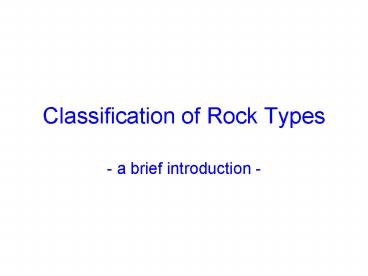Classification of Rock Types - PowerPoint PPT Presentation
1 / 55
Title:
Classification of Rock Types
Description:
Minerals are the building blocks of rocks! ... breccia: angular clasts. conglomerate: rounded clasts. Classification of Sediments ... – PowerPoint PPT presentation
Number of Views:922
Avg rating:3.0/5.0
Title: Classification of Rock Types
1
Classification of Rock Types
- - a brief introduction -
2
- Minerals
- - specific chemical composition
- - usually (but not necessarily) crystalline
- - inorganic
- - solid
- occur naturally
- Minerals are the building blocks of rocks!
- Rocks are aggregates of one (monomineralic) or
more (polymineralic) minerals!
3
(No Transcript)
4
The Rock Cycle
5
Rocks basically three different groups igneous
rocks crystallized from magma or
lava sedimentary rocks deposited from wind or
water metamorphic rocks igneous or sedimentary
rocks that recrystallized at elevated
pressure and temperature
6
Igneous Rocks form from melts magma (plutonic
igneous rocks) (molten rock within the
Earth) or lava (volcanic igneous rocks) (magma
that extrudes at the Earths surface)
7
plutonic rocks (e.g. granite) are coarse
grained because magma cools slowly within the
Earths crust volcanic rocks (e.g.
basalt) are fine grained because lava cools
quickly at the Earths surface or is even
quenched (volcanic glass)
8
granite
basalt
9
Igneous Rocks are ultramafic, mafic,
intermediate, or felsic ultramafic typical
mantle rock (peridotite) Mg and Fe silicates
(e.g. olivine) greenish, dark colour mafic typic
al oceanic crust rock (basalt, gabbro) forms
from low-viscosity melts mostly Mg and Fe
silicates (ol, opx) and minor aluminosilicates
(cpx, plag) greenish-grey dark colour (also
found on Moon, Venus, and Mars!)
increasing silica (SiO2) content
10
Igneous Rocks are ultramafic, mafic,
intermediate, or felsic intermediate intermedia
te between mafic and felsic typical island arc
volcanic rock (andesite) aluminosilicates (e.g.
cpx, plag, amphibole, mica) greyish
colour felsic typical continental crust rock
(granite) forms from high-viscosity
melts aluminosilicates and quartz light grey
colour
Note that in geological maps, cross-sections, and
profiles mafic rocks are shown in green and
felsic rocks in red!
11
(No Transcript)
12
Bowens reaction series
13
(No Transcript)
14
Bowens reaction series and melt polymerization
15
(No Transcript)
16
pl
opx
cpx
pl
ol
pl
classification of ultramafic rocks
17
(No Transcript)
18
(No Transcript)
19
(No Transcript)
20
(No Transcript)
21
Foid minerals may form from SiO2-deficient magma
Streckeisen diagram
22
volcanic rocks are usually classified according
to their chemical composition
TAS diagram Total Alkali vs. Silica
23
CIPW norm named after the four petrologists
(Cross, Iddings, Pirsson Washington) who
created it in 1931 calculation scheme by which
the major element composition of an igneous rock
is distributed between ideal mineral
compositions included in most geochemical
software packages for details on the CIPW norm
see, for example, http//www.uwgb.edu/dutchs/petr
olgy/cipw01.htm
24
Sedimentary Rocks sediment unconsolidated
(soft-rock) sedimentary rock consolidated
(hard-rock) examples mud --gt shale sand --gt
sandstone volcanic ash --gt tuff
25
(No Transcript)
26
Two major groups of Sedimentary Rocks --gt
clastic, chemical, and biogenic
sediments clastic sediments epiclastic
sediments erosion (and weathering) breaks down
rocks grains (solids!) are transported by wind
or water grains are deposited as epiclastic
sediments pyroclastic sediments products of
explosive volcanic eruptions fall-out from ash
clouds --gt pure pyroclastics particles (solids!)
are transported by wind and water and mix
with epiclastic sediments --gt volcanoclastics
27
rough sub-division of epiclastics according to
their grain size
28
(No Transcript)
29
breccia angular clasts
conglomerate rounded clasts
30
Classification of Sediments
31
things you have to know!
32
basic types of sedimentary environments
33
(No Transcript)
34
various depositional environments
35
(No Transcript)
36
(No Transcript)
37
eolian sediments, Zion Nationalpark, USA
38
eolian sandstone, Zion Nationalpark, USA
39
eolian sediments transported by wind (picture
shows eolian cross bedding)
40
(No Transcript)
41
now whole sequence gets tilted!
42
estuarine sedimentary environments
43
Chemical Sediments precipitate from aqueous
fluids their element content was transported as
solutes we distinguish marine and freshwater
precipitates examples carbonate --gt
limestone, dolomite silicate --gt chert phospha
te --gt phosphorite
44
Dunham classification of sedimentary carbonates,
e.g. limestone (note in geological maps and
profiles carbonates are always shown in blue!)
45
(No Transcript)
46
and a quick and dirty look at metamorphic rocks
metamorphic rocks are often classified according
to their typical mineral assemblages specific
mineral assemblages are typical of specific P-T
environments we distinguish different metamorphic
facies, such as low-grade, greenschist, and
amphibolite facies (in order of increasing P and
T conditions) we distinguish contact (close to a
pluton or a dike) and regional metamorphism
(affecting a large area)
47
(No Transcript)
48
granite
metamorphosed granite metagranite gneiss
49
metamorphic facies
50
(No Transcript)
51
(No Transcript)
52
(No Transcript)
53
for some pictures of common minerals go
to http//www.uwm.edu/Course/422-100/minerals.ind
ex.html igneous rocks go to http//www.uwm.edu/
Course/422-100/igrox.index.html sedimentary
rocks go to http//www.uwm.edu/Course/422-100/sed
rox.index.html metamorphic rocks go
to http//www.uwm.edu/Course/422-100/metrox.index
.html
54
Note Knowledge of the geological timetable is a
prerequisite for any discussion of geology.
Hence, it is mandatory that you know at least the
Eons and Eras, and the ages of the boundaries
within the Precambrian and the Precambrian/Cambria
n, the Paleozoic/Mesozoic, and the
Mesozoic/Cenozoic boundaries!!!
geological timetable
55
(No Transcript)































